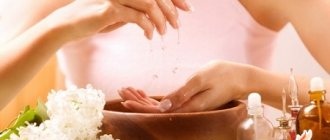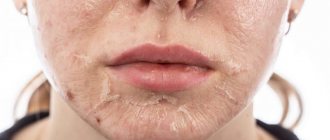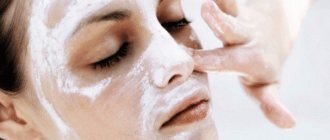Causes
The procedure does not pose a danger to the body, but causes microdamage to the skin. Redness after peeling is a protective reaction to irritation.
The causes of age spots may be:
- training rules . Before and between sessions, it is not recommended to visit the sauna or solarium.
- Improper facial skin care
- Failure of the cosmetologist the peeling technique
- The presence of inflammatory processes, wounds, herpes or acne in the acute stage.
Pigmentation may occur as a result of not using sunscreen during or after the course. Ultraviolet rays have a negative effect on irritated skin, which leads to the appearance of age spots.
Opinion of cosmetologists
Cosmetologists note the high relevance of the problem of facial pigmentation, especially in the summer, when a large number of freckles appear under the influence of sunlight. It is important not only to get rid of them seasonally, but also to take comprehensive measures on a regular basis.
Peels are recommended to be carried out in courses. Chemical and hardware methods provide a good effect.
What to do
To remove age spots that appear after peeling, an integrated approach is required. First of all, you need to contact the cosmetologist who performed the procedure.
The specialist prescribes medications and hardware therapy methods. The use of cosmetics is also required.
Subsequent facial cleansing procedures must be cancelled. This is necessary to prevent subsequent damage to the upper layer of the epidermis. The skin needs time to recover.
On this topic
- Peeling
Peeling PRX-T33
- Olga Aleksandrovna Kalinina
- October 21, 2020
Creams and ointments with a whitening effect are used to eliminate age spots. Only professional products that contain special enzymes are used.
The cosmetologist also performs a number of procedures aimed at restoring and caring for facial skin. Among additional methods, masks based on fish oil, lemon juice or fresh cucumber are popular. They are based on oil or honey, depending on your skin type. The masks are applied for 20 minutes, then removed with a soft towel using gentle blotting movements.
In cases where brown and red spots after peeling affect a large area of the face, mesotherapy or laser correction are prescribed. The duration of the course and the number of procedures are determined by the doctor depending on the degree of damage.
In order to completely remove age spots, about 10 procedures are often required. They completely disappear within 2-3 months.
Is peeling done at home effective?
Home peeling is a wonderful alternative to salon procedures. Its advantage is its ease of implementation, low cost and accessibility. However, before using peelings at home, you must consult a doctor and conduct an allergy test.
Recipe with badyaga and hydrogen peroxide
Badyaga and hydrogen peroxide are inexpensive but effective skin whitening products that can be purchased at any pharmacy. To carry out this procedure, you need to take badyagi powder and a 3% hydrogen peroxide solution in equal quantities and mix these ingredients. After this, you need to apply the mixture to previously cleansed skin, rub in with massaging movements for 5-10 minutes, then leave the product on the surface of the epidermis for another 10-15 minutes. Then you need to rinse off the product with warm water and moisturize the skin with cream. The procedure should be carried out 2-3 times a week.
Badyaga and hydrogen peroxide affect melanocytes, destroying them and inhibiting (suppressing) the synthesis of melanin pigment. Badyaga also intensively nourishes the skin and enhances regeneration processes. Therefore, it is recommended to use this remedy even after all manifestations of age spots have completely disappeared.
Peeling recipe based on fermented milk products
To combat age spots on the body, peeling with salt, soda and sour cream is excellent. It is quite aggressive, so it is not recommended for use on the face. To prepare such a scrub you need to take 1 tsp. “Extra” salt (very fine), 0.5 tsp. baking soda and mix with 5 tbsp. fat sour cream. This scrub should be applied to dry skin and rubbed in with massage movements until a slight burning sensation is felt. After this, it is advisable to steam the skin in a bath or warm shower and massage for 10-15 minutes with a natural bristle brush. The procedure can be carried out no more than 2 times a week.
Fermented milk products (in this case, sour cream) lighten the skin by reducing the number of active melanocytes. Salt and soda, in turn, exfoliate keratinized particles of the epidermis - this enhances skin renewal processes and even produces a rejuvenating effect. Acting in combination, peeling components can significantly improve the condition of the skin.
Peeling with oatmeal and almonds based on milk
To prepare this product you will need: 1 tbsp. ground almonds, 1 tbsp. oatmeal and 0.5 tbsp. skim milk. When mixing all the ingredients, a slurry should form, which in consistency resembles a cream. If the mixture is too thick, you can add a little mineral water. This homemade cosmetic product should be applied to the skin with massage movements, left for 15-25 minutes and rinsed with cool water. After the procedure, the skin can be wiped with tonic (for oily types) or lubricated with moisturizer (for dry types). It is recommended to exfoliate with oatmeal and almonds 1-2 times a week.
Milk, like all fermented milk products, intensely moisturizes and brightens the skin. And oatmeal and almonds contain a large amount of vitamins and minerals that penetrate into the deep layers of the skin, enhance lymphatic drainage, creating a lifting effect.
Peeling recipe with fruits and honey
To prepare this effective remedy for combating age spots on the face, you need to peel the pineapple, finely chop half of the fruit pulp and grind until a paste forms. Then you need to add half of the peeled papaya and 1-2 tbsp to the pineapple. liquid honey (preferably May honey). All ingredients must be thoroughly mixed (the most convenient way to do this is with a mixer). The product should be applied to the skin with light movements. It is forbidden to rub this product and leave it for more than 7-8 minutes - this can lead to burns from the natural acids contained in fruits. After this, you need to complete the procedure by washing with warm water and applying a moisturizer. It is advisable to carry out the procedure no more than once every 7 days.
This peeling is considered one of the most powerful, and this is because fruits (namely their acids) actively affect the production of melanin, suppressing this process, and also help the keratinized cells of the epidermis to exfoliate faster. Honey prevents skin from drying out and enriches it with vitamins.
Remember that any product that is included in homemade peels can lead to hypersensitivity reactions (especially for highly allergenic products such as honey, nuts, citrus fruits, and dairy products). Also, such procedures should not be carried out more often than necessary, and the duration of one session should not be increased. This can lead to cracks, microtraumas, chemical burns, allergic reactions and deterioration in the general condition of the skin.
Prevention measures
In order to prevent facial redness and the appearance of age spots, it is important to follow a number of rules and prepare in advance for the procedure.
In cases where small spots appear after the first session, subsequent procedures should be abandoned and the cosmetologist should be informed of the side effect.
Before and after the procedure, it is important to protect your facial skin from exposure to ultraviolet rays for a week. To do this, apply a protective cream before going outside.
From 11 a.m. to 5 p.m., you should completely avoid exposure to the sun, as at this time you can get sunburn on injured skin. When it appears, ointments, masks and creams with a cooling effect are used.
For young skin and in the absence of serious problems, it is better to choose a light superficial peeling. 2 procedures per month are enough. In this way, it is possible to remove dead tissue and eliminate the appearance of age spots, since the effect is only on the upper layer of the epidermis.
Throughout the entire recovery period, it is important to refrain from using cosmetics, especially foundation and liquid powder. They clog the pores, the skin stops breathing, which leads to the appearance of pigmentation.
In the first 2-3 days after peeling, any exposure to the facial skin should be avoided, as it is irritated. There are microcracks on the surface through which infection can penetrate. As a result, not only redness will occur, but other side effects and complications will also appear.
Facial peeling is a popular skin cleansing procedure. But only correct implementation of the procedure, compliance with the rules for preparation and care after sessions will significantly reduce the risk of side effects in the form of redness and the appearance of age spots. When they appear, you must immediately contact the cosmetologist who performed the procedure.
Which procedure is suitable for the problem: the most effective types of skin exfoliation
Age spots are accumulations of melanin in the epidermis and dermis . The choice of peeling method depends on how deep they are. There are 3 types of peeling to combat pigmentation.
We recommend: Home peeling from Victoria Boni. Cooking recipe and procedure features
Laser
The most effective method for removing age spots. In cosmetology, combined lasers and installations with a “forced cooling” function are usually used, which minimize the thermal effect on the skin.
Under the influence of a laser, the liquid in the epidermis turns into steam , which leads to intense peeling. The result is a process of cell renewal and increased collagen production.
The healing period lasts a week, and the entire rehabilitation period takes from 3 weeks to 1.5 months. During this time, the appearance of your skin can be alarming.
The rejuvenation effect lasts for a long time , depending on the state of the body and the individual characteristics of the recovery processes. When working with a laser, it is possible to regulate the depth of its penetration, so the device is used to remove pigmentation at the border of the epidermis and dermis.
Chemical
Chemical peeling involves the use of acids or enzymes:
- Enzymatic .
Gentle, superficial treatment of skin, especially problem skin. It involves applying an enzyme preparation that breaks down the protein structure of keratinized cells. After 15 minutes, the drug is removed using a tonic and a soft cloth. With regular use, the condition of the skin improves and the complexion is refreshed, pigment spots lighten. Enzyme peeling is carried out no more than twice a month. Indicated for removing pigmentation on the surface layers of the skin. - Acid. Acid burns cause chemical peeling of the skin. The depth of peeling depends on the concentration of acids. If the pigmentation is deep, it is necessary to remove a larger layer of skin; the acid concentration reaches 90%. Glycolic acid has the most gentle effect. Salicylic, lactic, and benzoic acids are also used.
Important! After deep acid peeling, exposure to direct sunlight on the skin contributes to the appearance and enlargement of age spots.
Peeling the skin with acids is a painful procedure that requires extensive preparation and experience.
Retinoic
Retinoic (yellow) peeling is designed to lighten the skin using retinoic acid , which penetrates into the deepest layers of the skin and stimulates the formation of new cells.
As a result, these cells literally displace the upper stratum corneum, which is manifested by active peeling. Suitable for mature skin of women over 40 years old.
Retinoic peeling is done in a course of three procedures at intervals of 10 days. Use if there are large and dark pigment spots on the skin.
Indications for use and effectiveness
One of the purposes of peeling is whitening and evening out skin tone. It is indicated for pigmentation, uneven complexion, and is suitable for lightening freckles and post-acne, marks from squeezed pimples. It is very difficult to remove age-related melasma with peeling.
As a result of the procedure, the keratinized cells of the epidermis, in which pigmentation disorders most often occur, are exfoliated. This layer gives way to a new one. Some medications slow down the production of melanin, which provides the skin with an even tone.
To regenerate the skin, cosmetologists most often recommend doing a medium peel. This depth of exposure is usually sufficient to eliminate the defect. Superficial cleaning is considered less effective, and deep peeling is fraught with the appearance of scars and is rarely used against pigmentation.
The process of getting rid of age spots from the skin is planned for autumn and winter. In the spring-summer season, peeling can provoke the appearance of an additional “scattering” of dark spots that appear under the influence of active sun. The number of sessions depends on the complexity of the problem. Usually 4–10 procedures are required if the peeling is superficial. The interval between them is from 1.5 to 2 weeks. For mid-cleaning, the interval increases to 1–2 months, and the number of sessions is reduced to 1–3.
Attention! Peeling for hyperpigmentation is effective if the cause of the problem is not related to diseases of the internal organs. Otherwise, melasma may appear again.
Reviews from cosmetologists about glycolic peeling
This is not the first year I have been working with this drug. The result is always expectedly positive. The only thing I encountered was clients’ failure to comply with my instructions during the recovery period. For the first time, I try to convince the client to make the percentage concentration no higher than 40, since in my practice I have encountered allergic reactions to the 70% composition.
I believe that the use of peeling, even with low acid power, can only be trusted by professionals. The cosmetologist will more accurately calculate the required dose and also give recommendations for further care.
In my work I completely switched to peelings with glycolic acid. They work great both as a basic skin preparation and separately. I noticed that compared to other fruit acids, glycol-based cleaning gives faster results.
I have been in the field of cosmetology for many years. I often encountered unwanted reactions to peeling compounds. Although glycolic acid is quite gentle, I prefer to do the first procedure with a lower percentage to see the individual reaction of the body.
Glycol-based peels are the most convenient to use, as they do not cause severe discomfort to the client. Although I warn you that at high concentrations a burning sensation is felt. For those who have a high sensitivity threshold, I suggest replacing one aggressive procedure with a course of cleansing with low-power acid. If the condition of the dermis is not too advanced, the effect is obvious.











